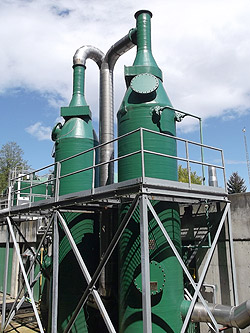Odour Control
Our target is to minimize odours. If you smell something you believe is related to an RDN facility, we encourage you to report it as soon as you can so we can investigate the cause and potentially relieve the odour. Investigations look at wind direction, plant activities and other events in the community.
What causes odour?
Most odours from wastewater treatment are caused by the breakdown of partially digested food. The most of the unpleasant odours are from food containing nitrogen or sulphur. For example, proteins produce particularly unpleasant odours since all proteins contain nitrogen and some also contain sulphur. In contrast, carbohydrates and fats do not contain nitrogen, but some contain sulphur.
What is being done to control odour?
The following activities reduce or eliminate odours from FCPCC:
- Ultraviolet light purifies air from the trickling filter.
- Ferrous chloride reduces the release of hydrogen sulphide gas.
- Air from grit tanks, solids contact tanks, biosolids digestion, and biosolids dewatering is captured and treated with biological and chemical scrubbers and bio-filters.
- The RDN has partnered with the Vancouver Island University Applied Environmental Research Laboratories to fingerprint odour emissions. This information is being used to design the appropriate control measures that will improve air quality.
- Odour control improvements are part of the FCPCC Expansion and Odour Control Upgrade Project.
The following activities reduce or eliminate odours from GNPCC:
- Ferrous chloride reduces the release of hydrogen sulphide gas.
- Two carbon scrubbers and a biofilter capture and remove odours from the air.
Is it true that spawning herring create odours near French Creek?
Every year around March, herring spawn off the shores near French Creek. Roe wash up on nearby beaches and decompose into the summer. The decomposing eggs release hydrogen sulphide and winds can carry the odors towards the highway and FCPCC. Occasionally, odours detected around FCPCC are caused by herring roe.
View past stories from CTV News and CHEK News for more details.
To report odours, call:
French Creek Pollution
Control Centre
250-248-5794
Nanoose Bay Pollution
Control Centre
250-248-5794
Greater Nanaimo Pollution
Control Centre
250-758-1157
After hours
1-800-862-3429
